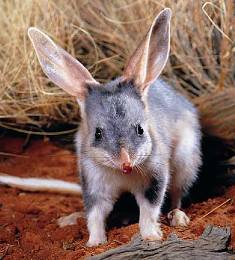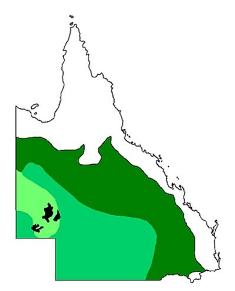Greater bilby
Safeguarding the endangered greater bilby in Queensland
The greater bilby, an ecosystem engineer, is an endangered animal. Understand what’s being done in Queensland to help the bilby species bounce back.

Fast facts
Common name: Greater bilby
Scientific name: Macrotis lagotis
Family: Thylacomyidae
Status: Endangered
Habitat: Mitchell grass plains, sandstone ridges, gibber plains, rocky soils with little ground cover, hummock and tussock grasslands, and Acacia shrublands.
Species overview
The greater bilby is a burrowing marsupial that belongs to the bandicoot family. The species is estimated to be more than 15 million years old.
Once widespread across mainland Australia, bilbies now occur in fragmented populations. Scientific records show greater bilbies lived in Queensland in the late 1800s, but sightings were not recorded for many years after this time. In 1988, scientists rediscovered the greater bilby in far western Queensland.
Wild populations of the greater bilby are found in several locations in western Queensland including Astrebla Downs and Diamantina National Parks and some pastoral properties. A captive breeding program is also underway at Currawinya National Park in south-west Queensland.
Bilbies are spiritually significant to First Nations people. The term bilby is derived from the Ullaroi language name—Bilba. There are at least another 20 names used for this animal across Australia.
Ecology and behaviour
The greater bilby plays an important role in the ongoing health and function of ecosystems through water filtration, soil health and species protection.
Bilbies are excellent burrowers, acting as ‘ecosystem engineers.’ Their digging helps water infiltrate the soil, and leaf litter and seeds to collect in the shallow scrapes. These efforts create fertile pockets, providing the conditions for plants to germinate. Continual digging helps cycle organic material and nutrients back into the ground.
Bilby burrows are important landscape features and may provide shelter for other species, especially after fire.
While greater bilbies have sharp hearing and a well-developed sense of smell, they can’t see well. These animals keep their noses down when they run, contributing to their unusual gait.
Greater bilbies are nocturnal omnivores, emerging after dark to feed on insects and their larvae, seeds, spiders, bulbs, fruit, fungi, and small animals. These marsupials do not need to drink water. They get moisture from their food.

Characteristics
The greater bilby has:
- silky pale blue-grey upper body fur
- a long, pointed nose and large rabbit-like ears
- a compact body up to 55cm long
- a crested black-and-white tail up to 29cm long
- strong forelimbs with long claws.
Threats
- Introduced predators such as wild dogs, red foxes and feral cats
- Competition for food from livestock and introduced animals
- Habitat loss and fragmentation
- Changing fire patterns.
What’s being done?
Habitat protection, controlling threats from predators and an intensive recovery program aims to increase bilby populations in Queensland.
- Queensland’s national parks and protected areas play an important role in protecting threatened species. As part of the Queensland Protected Area Strategy 2020–2030, we’re acquiring more land to expand our protected area system and help conserve critical species habitat.
- We protect each area’s natural and cultural values, manage and control threats and build ecosystem resilience and health. We work closely with each area’s Traditional Owners and other partners to manage fire in the landscape. We conduct conservation planned burns using low intensity, cool burning practices that result in a patchy or mosaic burn pattern. This minimises the impact on fire sensitive ecosystems and retains important habitat features for native fauna including bilbies.
- In partnership with the Save the Bilby Fund, we have re-introduced captive-bred bilbies into Currawinya National Park near Hungerford on the Queensland-New South Wales border. The ongoing breeding program aims to create a viable population that can help repopulate other wild populations of bilbies. The park’s 2,500-hectare enclosure features a specially-designed fence to reduce the threats from predators and enable the bilbies to live and breed in safety.
- Ongoing research in areas near Birdsville provides insights into how greater bilby populations change over time and respond to management actions.
- We monitor bilby populations by carrying out ground surveys and, in the past, through aerial and drone surveys. This monitoring provides vital information to guide decisions about protecting the species.
- Our Queensland Parks and Wildlife Service (QPWS) rangers educate neighbouring landowners surrounding about how to help reduce predators and manage bilby habitat.
- We convene a Queensland Bilby Reference Group that provides a way to exchange information between the different groups managing bilbies, helping to ensure efficient and effective management. It also helps to implement priority actions associated with bilby recovery in Queensland.
- We also participate in the National Greater Bilby Recovery Team.
Who is helping?
- Save the Bilby Fund Since 2017, we have partnered with the Fund to deliver the re-introduction program at Currawinya National Park, captive breeding and monitoring programs.
- Dreamworld Wildlife Foundation
Dreamworld has a captive breeding agreement with us to support the national bilby meta-population initiative.
How you can help
- Make a donation to support our work to protect and recover the greater bilby.
- At Easter time, consider buying a chocolate bilby, where portions of each sale are donated to bilby research and conservation efforts.
- If you are a property owner neighbouring Astrebla Downs, Diamantina or Currawinya National Parks, you can control feral animals, such as foxes, dogs and cats, from your land to prevent them from preying on bilbies.
- Find out more about how you can help support threatened species efforts.